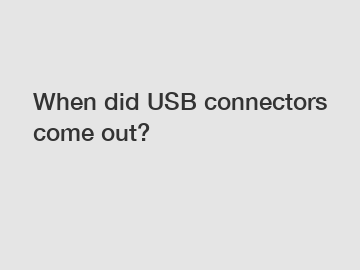Dec. 29, 2023
Electrical Equipment
When did USB connectors come out?
The emergence of USB connectors has revolutionized the way we connect devices to our computers. But have you ever wondered when these versatile connectors made their first appearance? Let's delve into the history of USB connectors and explore their evolution over the years.
1. The Early Years:

USB, which stands for Universal Serial Bus, was first introduced to the market in 1996. A team of engineers from Intel, Compaq, Microsoft, Digital Equipment Corporation, and Hewlett-Packard collaborated to develop this groundbreaking technology. The initial USB specification, USB 1.0, featured a data transfer rate of 12 Mbps. However, it was not until USB 1.1 was released in 1998 that USB connectors gained widespread adoption.
2. The Evolution of USB:
USB connectors garnered significant attention due to their simplicity, ease of use, and versatility. Over the years, USB connectors experienced several iterations to keep up with the ever-increasing demands of technology. USB 2.0, released in early 2000, offered a significant speed boost compared to its predecessor, reaching transfer rates of up to 480 Mbps. This upgrade made USB connectors suitable for high-speed peripherals such as external hard drives and digital cameras.
3. Enter USB 3.0:
USB 3.0, also known as USB 3.1 Gen 1, arrived on the scene in 2008, providing users with a dramatic speed enhancement. Its data transfer rate reached a staggering 5 Gbps, ten times faster than the previous version. This improvement opened up a new era of faster data backups, file transfers, and multimedia experiences. USB 3.0 connectors, identifiable by their blue color, began to replace their predecessors, offering backward compatibility with USB 2.0 devices.
4. The Rise of USB-C:
As technology continued its rapid advancement, the need for even faster data transfer speeds and more compact connectors became apparent. USB-C, the latest iteration of USB connectors, was officially introduced in 2014. This breakthrough design offers a reversible connector, allowing users to insert USB-C cables in either orientation. This eradicates the age-old frustration of fumbling with USB connectors to find the correct way to plug them in. USB-C also supports Thunderbolt 3, providing an astonishing data transfer rate of up to 40 Gbps.
5. The Impact and Future:
USB connectors have become ubiquitous in our daily lives. They have replaced a myriad of legacy connectors, such as PS/2, parallel, and serial ports. Nowadays, virtually all electronic devices incorporate USB ports, including computers, smartphones, tablets, gaming consoles, and even vehicles. The convenience and standardization brought about by USB connectors offer a seamless user experience and enable the effortless connection of various peripherals.
In conclusion, USB connectors emerged in the mid-1990s and have since undergone several advancements. From the initial USB 1.0 release to the ultra-fast USB-C connectors of today, USB technology keeps evolving to meet the demands of the ever-changing digital landscape. USB connectors have simplified our lives by offering faster data transfer rates, compatibility across devices, and convenient plug-and-play functionality. As we move forward, it is exciting to imagine what further developments USB connectors will bring to enhance our technological experiences.
For more lp24, aviation plug 3 pin, 2 pin waterproof plug and socketinformation, please contact us. We will provide professional answers.
Previous: How does a Balcony Solar System Work?
Next: Which lithium iron phosphate battery quotes provide the best value for money?
If you are interested in sending in a Guest Blogger Submission,welcome to write for us!
All Comments ( 0 )